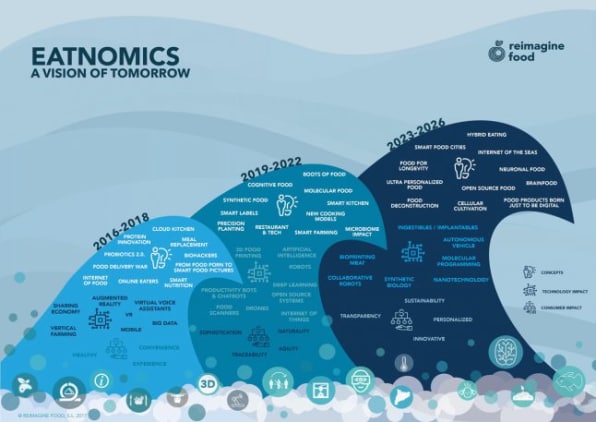Take technology like the internet-of-things, mix it with trends like lactose-free, high-protein, organic, and natural, sprinkle in environmental challenges like depleted soils and oceans, and pass the stew through a commercial meat grinding machine. The sum is the present–and future–of food, where a lot of funny things happen on the way to the food market. Beer is produced by artificial intelligence. Fridges self-order your next meal. Foods cure and prevent disease as much as fill our bellies. And chefs create “an open source hyperloop of culinary creativity with the ability to deconstruct food to be sent anywhere on the planet,” says food futurist Marius Robles.
The future of food is already pretty far-out. Trends like Soylent, prawns made of vegetables, and the fact that we spend more money now in restaurants than in supermarkets, would all confuse our grandparents. And it’s going to get weirder. Before long, we’ll be slicing and dicing vegetable DNA using CRISPR and produce the majority of our calories in controlled, rather than open, environments, whether it’s vertical farms or minutely engineered endangered fish hatcheries. The changes coming to the way we produce, consume, and throw away food, could overturn the kitchenette and upset the apple cart, at least in the imaginings of Reimagine Food, a Barcelona think-tank that brings together hundreds of food companies, entrepreneurs, and future-watchers.
“Cities will be able to analyze their inhabitants’ quality of life through their food [consumption], and arable land will be rendered unnecessary,” says its Eatnomics report. “We will also discover smart nutrition for a total personalization of our diets, which will also affect the way in which food is produced and distributed.”

Its three-wave schematic, seen here, shows how the revolution could build on itself. First, about now, there’s the sharing economy, food biohacking, and food box delivery wars. Next, between 2019 and 2022, there’s food scanners that help divine more accurately what we’re eating, smart food labels, and 3D food printing. Then, in the next decade, there’s food-as-medicine, food personally adjusted to our microbiome, and food at the molecular and implantable level.
“Big data will help us create search engines to identify patterns and generate wide-reaching predictions, anticipating our desires and consumer impulses,” says Robles, head of Reimagine Food, in an email. “Sometimes, we’ll wonder where a food comes from, the laboratory or a field. We’ll experience personalized food in all its splendor, with our genome as proof, as we live in the controversial algorithm economy.”
Technology offers the opportunity to produce food more efficiently, whether it’s through the precision targeting of chemicals and water or the conservation of soils through soil-less agriculture. Surely we’ll work out ways to preserve more of the 40% of calories we currently throw away (or lose from the food chain). And, if there’s not enough available space on Earth, there are always other planets to plow.
“I’m sure that by 2022 we’ll have a series of crops growing on Mars,” Robles says. “Today, there is a preliminary expedition by some British scientists to plant lettuce on Mars in 2018. I’m sure we’ll be using Mars as a second source of agricultural resources.” First, there was agriculture, then aquaculture, then aquaponics, and, in the future, perhaps, “astroculture” as well.
(69)